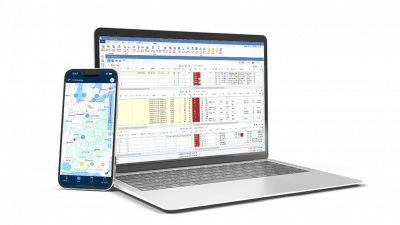In an era where every drop of fuel counts, carriers are constantly seeking ways to optimize their operations and boost their bottom line. Enter fleet telematics — a transformative technology revolutionizing how carriers manage their fleets and fuel consumption.
Fleet telematics provides real-time insights into vehicle performance, location, and fuel efficiency.
This article explores how carrier businesses can leverage fleet telematics to dramatically improve fuel efficiency, including practical steps to implement this technology effectively and how integrating telematics with a Transportation Management System (TMS) amplifies these benefits.
What is Fleet Telematics?
Fleet telematics combines GPS tracking with onboard diagnostics to gather and transmit data about vehicle location, driver behavior, engine performance, and more. This technology offers real-time insights into vehicle performance, route efficiency, and driver behavior, enabling carriers to make data-driven decisions that enhance fleet efficiency and reduce costs.
Telematics helps optimize routes, monitor fuel consumption, track maintenance needs, and improve driver safety. It provides a comprehensive view of fleet operations, allowing carriers to quickly identify and address inefficiencies.
Benefits of Fleet Telematics for Fuel Efficiency
The impact of fleet telematics on fuel efficiency is multifaceted. Let’s explore some of the key ways this technology can help carriers save on fuel costs:
Reduced empty miles
One of the biggest fuel wasters in the transportation industry is empty miles — when trucks travel without cargo. Fleet telematics helps tackle this issue by optimizing routes and loads. By providing real-time data on vehicle locations and load status, telematics enables dispatchers to make smarter decisions about route planning and load matching.
This optimization doesn’t just reduce fuel consumption; it also increases operational efficiency. Carriers can handle more deliveries with the same number of vehicles, maximizing their resources and boosting profitability.
Telematics also helps minimize dwell time — the time trucks spend waiting at loading docks or delivery points — further improving fuel efficiency.
Improved driver behavior
Driver behavior significantly impacts fuel consumption. Habits like excessive idling, harsh acceleration, and speeding can dramatically increase fuel usage. Fleet telematics allows carriers to monitor these behaviors using Electronic Logging Devices (ELDs) and provide targeted coaching to drivers.
By identifying and correcting inefficient driving habits, carriers can implement driver training programs to promote more fuel-efficient techniques, improve safety, and reduce vehicle wear and tear.
Preventative maintenance
Well-maintained vehicles are more fuel-efficient. Telematics systems provide valuable data on vehicle performance, enabling carriers to implement adequate preventative maintenance programs. By addressing minor issues before they become major problems, carriers can ensure their vehicles are always running at peak efficiency.
Regular maintenance based on telematics data helps avoid costly repairs and unexpected downtime. It also extends the lifespan of vehicles, providing a better return on investment. Discover more about the importance of preventative maintenance and repair management in fleet operations.
Increased on-time delivery
Efficient route planning and dispatch, facilitated by fleet telematics, lead to more on-time deliveries. This enhances customer satisfaction and reduces fuel wastage from detours and delays. When drivers can stick to optimized routes without unexpected diversions, they consume less fuel and complete more deliveries in less time.
Measuring and Calculating the ROI of Fleet Telematics
Implementing telematics into fleet management requires an initial investment, but the returns can be substantial. Here’s how carriers can measure and calculate the return on investment (ROI) of their telematics systems:
Key metrics
Telematics data collection is essential for measuring success. To assess the impact of fleet telematics, carriers should track several key performance indicators (KPIs). These include:
- Fuel Cost Savings: Compare fuel consumption before and after implementing telematics.
- Reduced Maintenance Expenses: Track the decrease in repair costs due to preventative maintenance.
- Improved Delivery Times: Measure the increase in on-time deliveries and reduction in transit times.
- Decreased Idle Time: Monitor the reduction in unnecessary idling.
- Improved Driver Behavior: Track changes in speeding incidents, harsh braking, and other inefficient driving habits.
Carriers can use telematics software integrated with a TMS to collect and analyze data from various sources, offering a deeper understanding of business impact.
Calculating ROI
To calculate the ROI of fleet telematics, compare the gains (such as fuel savings and reduced maintenance costs) calculated using KPIs against the costs of implementing and maintaining the system. The formula is:
ROI = (Gains from Investment – Cost of Investment) / Cost of Investment
For example, if a carrier spends $50,000 on implementing telematics and saves $75,000 in fuel and maintenance costs over a year, the ROI would be:
ROI = ($75,000 – $50,000) / $50,000 = 0.5 or 50%
This figure means the carrier has recovered their original investment plus an additional 50% in savings.
Consider additional benefits like improved driver safety and reduced accident rates when evaluating ROI. Although these are more challenging to quantify, they produce significant value as they contribute to the company’s reputation, insurance premiums, and legal liability.
How to Implement Fleet Telematics for Fuel Efficiency
Implementing fleet telematics effectively requires a strategic approach. Here are the key steps carriers should follow:
Determine your goals
Set clear, specific, and measurable objectives for implementing fleet telematics. For instance, you might aim to reduce overall fuel consumption by 10% within the first year, decrease empty miles by 15%, or improve average miles per gallon across the fleet by 5%.
These goals serve as a roadmap for your implementation process and provide benchmarks for measuring success. They also help communicate the purpose and expected outcomes of the new system to stakeholders, including drivers and management.
Include both short-term goals (immediate fuel savings) and long-term objectives (reducing carbon footprint or achieving sustainability targets). By integrating your telematics system with a TMS, you can set even more comprehensive goals that encompass not just fuel efficiency but overall operational effectiveness.
Choose the right solution
Selecting the appropriate telematics solution requires thoroughly assessing your fleet’s specific needs and integration capabilities with existing systems.
Consider these factors when evaluating telematics solutions:
- Compatibility: Ensure the system can integrate seamlessly with your existing TMS and other software.
- Ease of Use: The solution should be user-friendly for both drivers and administrators.
- Data Quality and Reliability: Look for systems that provide accurate, real-time data.
- Support and Training: Choose a provider that offers comprehensive training and ongoing support.
- Scalability: The system should be able to grow with your fleet.
The goal is to find a solution that not only meets your current needs but can also adapt to future challenges. A system that integrates well with your TMS can provide a more holistic view of your operations, allowing for better decision-making and more efficient fuel management.
Educate and train drivers
Driver buy-in and proper usage are crucial for telematics success.
Explain the system’s benefits to drivers, including reduced paperwork, improved safety, and potential performance-based incentives. Provide comprehensive training through hands-on sessions, instructional videos, and written guides. Consider designating “telematics champions” among drivers for peer support.
Implementing a feedback system where drivers can share their experiences and suggestions is also helpful. This will refine the system and make drivers feel valued and involved in the process.
Optimize load matching and dispatch
Efficient load matching and dispatching are crucial to maximizing fuel efficiency. Telematics data, when used effectively, can significantly improve these processes. It enables more accurate and efficient dispatching decisions by providing real-time information on vehicle location, capacity, and performance.
Use telematics data to:
- Identify the most suitable vehicle for each load based on location and capacity
- Optimize routes to minimize empty miles
- Adjust schedules in real time based on traffic conditions or unexpected delays
Integrating telematics with a TMS can further enhance optimization. PCS’ carrier dispatch solution ensures dispatchers have the visibility and collaboration needed during dispatch, reducing empty miles and improving delivery times.
Implement preventative maintenance
Preventative maintenance is a crucial aspect of fuel efficiency that’s often overlooked. Well-maintained vehicles consume less fuel and are less likely to break down, leading to significant cost savings over time.
Use telematics data to implement a robust preventative maintenance program:
- Set up alerts for regular maintenance based on mileage or engine hours
- Monitor engine diagnostics to catch potential issues early
- Track fuel efficiency to identify vehicles that may need attention
Early identification and resolution of these issues can avoid more severe problems later on that can increase fuel consumption and vehicle downtime.
Monitor and analyze performance
Continuous monitoring and analysis are key to realizing long-term benefits from your telematics system. This involves more than just collecting data; it requires actively using that data to drive decisions and improvements in fleet management.
Review established KPIs and fleet management metrics regularly, looking for trends and patterns in the data. Use these insights to inform decision-making, such as adjusting routes, providing additional driver training, or prioritizing vehicle maintenance.
Integrating your telematics system with your TMS can provide even deeper insights by combining operational data with fuel efficiency metrics. Our reporting and analytics tools can help you make sense of this wealth of data, turning it into actionable insights that drive continuous improvement in fuel efficiency and overall fleet performance.
Increase Fuel Efficiency With Fleet Telematics and PCS TMS
Integrating fleet telematics with a robust TMS can significantly amplify the benefits of both technologies. By combining real-time telematics data with the powerful planning and optimization capabilities of a TMS, you’re not just saving fuel — you’re fueling the future of your business.
PCS TMS for Carriers offers a comprehensive solution that seamlessly integrates with telematics systems, providing a unified platform for managing all aspects of your fleet operations. From optimized dispatching to detailed performance analytics, our system helps you leverage your telematics data to its fullest potential.
Ready to take your fleet efficiency to the next level? Discover more about how PCS TMS for Carriers can help you improve fuel efficiency and reduce operating costs. Schedule a free demo to see how PCS TMS can optimize your fleet operations and drive your business forward in the digital age.



